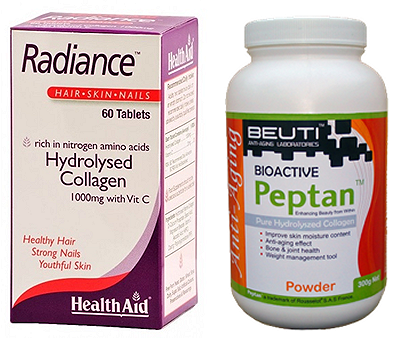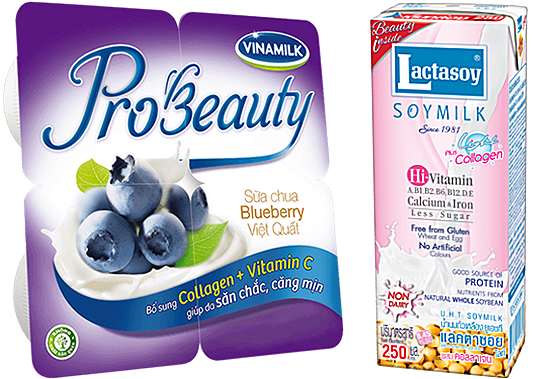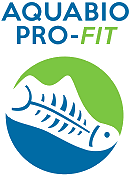Collagen is the most important protein produced by the human body, it is mainly formed by the amino acid glycine (33%), proline and hydroxyproline (22%) (primary structure) in a triplex helix which is formed by three α chains. Each alpha chain is composed of approx. 1014 amino acids with a molecular weight around 100 kDa. These chains are coiled into a left-handed helix with three amino acids per turn (secondary structure). The chains are twisted around each other into a triple helix to form a rigid structure (tertiary structure). The super helix represents the basic collagen structure (quaternary structure). This collagen structure is very stable because of the intramolecular hydrogen bonds between glycine in adjacent chains.
Nearly 28 types of collagen have been identified, but collagen type I is the most common in skin, bone, teeth, tendon, ligaments, vascular ligature, and organs. Collagen type II is present in the cartilages. For collagen type III, the skin, muscle, and blood vessels are the most common sources of this protein. Type IV has been reported in the epithelium-secreted layer of the basement membrane and the basal lamina. Collagen type V is one of the principal components of cell surfaces and placenta. Collagens are different according to their α-chain composition, depending on the repeat and length o he Gly-X-Y amino acid repetition, with and without interruptions, also the occupation of the X and Y positions by proline and its hydroxylated form, hydroxyproline, respectively.
Native collagen type I can be extracted from different fish tissue such as bones, skin, and scales or waste fish side-streams, or other sources such as chicken, bovine, duck, and rabbit skin. Extraction can be carried out by an acid or alkaline treatment. Extraction under acid treatment is usually applied for extraction of collagen type I from tissues of porcine or fish skin origin. Acetic acid is the most common reagent for collagen extraction. The concentration of this acid will affect the final pH value changing the electrostatic interaction and structure. It also determines the solubility and extraction capacity from animal tissue. A combination of both acidic and enzymatic treatment produces a higher and more efficient collagen extraction process. Pre-treatment conditions, dialysis, and source of extraction are the main factors that determinantal collagen characteristics such as molecular weight, amino acid composition, and molecular structure.
Collagen is a high molecular weight structural protein that is found in the extracellular matrix of connective tissues including the tendons, ligaments, bones, skin, cartilage and teeth. Depending on the location in the body, these fibrous proteins have different mechanical requirements, sometimes imparting stiffness and support while in other cases storing mechanical energy through their elasticity. Gelatin is the partially hydrolysed form of collagen and consists of a mixture of peptides and proteins.
There are five most common types of collagen (more)
- Type I: skin, tendon, vasculature, organs, bone (main component of the organic part of bone)
- Type II: cartilage (main collagenous component of cartilage)
- Type III: reticulate (main component of reticular fibres), commonly found alongside type I
- Type IV: forms basal lamina, the epithelium-secreted layer of the basement membrane
- Type V: cell surfaces, hair, and placenta
Collagen has mostly been sourced from porcine and bovine origin, but recombinant production and marine sources are also becoming more prevalent. In particular, the outbreak of bovine spongiform encephalopathy (BSE) in the 1980s and religious constraints have driven the demand for alternative sources. Moreover, marine collagen can be obtained from a variety of sources, such as fish side streams as well as marine sponges or jellyfish. The skin, scales and bone of fish are a source of Type I collagen, which is the most abundant form of collagen and is commonly used in healthcare and food products. However, Type II collagen can also be isolated from fish cartilage and is often used for medicinal purposes. With the increasing demand for personal care and health supplements, collagens are now widely used as ingredients in nutraceutical, cosmetics and pharmaceutical products.
Recent research into the effect of collagen on various body functions has shown that collagen has several benefits. These include the improvement in elasticity of skin by stimulating the production of collagen by the skin cells themselves, thus counteracting aging-related changes and potentially leading to a more youthful and vibrant skin, antioxidant properties that may prevent and even repair skin damage caused by environmental factors and positive effects on tendon flexibility, ligaments stability, muscle and bone integrity and bone metabolism.
The global demand for collagen and gelatine from the industry throughout the world is considerable and still rising. Marine collagen is often used in a purified form in cosmetic creams and gels. In sunscreen lotions, collagen can be used as a functional ingredient to protect the skin against UV damage and promote skin regeneration. Collagen can also be used as a supplement, to reduce the effects of ageing and maintain skin, hair, nails and body tissues by stimulating the synthesis of new collagen. Aside from the health benefits, collagen is also used to improve the rheological properties of sausages and as sausage casings, edible films and as a barrier to oxygen.
Gelatin is primarily used in the food and pharmaceutical industries. In food products, gelatin is used as an additive to enhance texture, water-holding capacity, stability and clarification. For bakery products, gelatin is used extensively as a setting agent, stabilizing substance or foam producing material in pies, breads, and cakes. Almost 10% of the edible gelatine is used in the pharmaceutical industry for capsules and emulsions. One of the most appreciated properties of gelatine is its gel-forming capacity. Fish gelatine, however, does not tend to form strong gels but may therefore have a market when non-gelling gelatine applications are required (i.e. shampoo with protein).
On the market collagen products can be find in three different forms (more)
- Native collagen, which is composed of a large triple helix chain of amino acid and strengthens the structure of the body.
- Gelatin, which is obtained by the partial hydrolysis of collagen. As gelatin dissolves in hot water and gels when it is cooled, it is frequently used in culinary applications, such as gummies, candies, jellies, sauce thickeners, etc. Gelatin also has a role in pharma applications, often used as excipient for making soft and hard capsules.
- Collagen peptides, small bioactive peptides obtained by enzymatic hydrolysis of collagen that are highly bioavailable. They act as building blocks, renewing body tissues, such as skin, bones and joints and are also recommended for improving skin moisture as well as hair and nail strength. Two examples of these products are shown in Figure 1.3.1.

Collagen is also used as an active ingredient in functional foods, as shown in Figure 1.3.2.

Given the various benefits and functionalities of collagen and gelatine, there are several companies selling these products. While the market for porcine and bovine sources is well-established, consumer health and religious preferences are also paving the way for marine-based products.
Information about the collagen and gelatine products that are currently on the market can be found in Supplementary Table 1.3.1..
In 2017, fish collagen dominated the market due to the presence of proteins, essential fatty acids, minerals and vitamins. As a result, nutraceuticals are one of the main applications for marine collagen. The main market for marine collagen was Asia-Pacific. The demand is high in Japan and China, with the latter being one of the major manufacturers and exporters for marine products. In the EU, the market is driven by an increased use of health supplements, with Germany and UK leading the way.
By the end of 2018, the marine collagen market is estimated to be valued at US$620.3 million (approximately €534 million) and is projected to reach US$897.5 million (approximately €772 million) by 2023 with a CAGR of 7.7%. The prices vary from €10 to €15/kg depending on the traceability, degree of hydrolysis, taste and purity. The market growth is triggered by the demand for more nutritious and enhanced sensory attributes in food products. Greater health and wellness awareness have also led to increased consumption of marine collagen for its health benefits and better bioavailability compared to other forms of collagen. Type I collagen is expected to have the highest growth over the coming 5 years, with the main sources of marine collagen arising from skin, scales and muscles of fish.
The competition in the global collagen market is intense, which is a reflection of the great number of competitors who have a strong platform as raw material suppliers. Gelita (DE) and Rousselot (FR) are two of the more prominent companies operating in the global collagen market. (more)
For collagen and gelatine, there are well-established markets for ingredients based on porcine and bovine sources, with large companies such as Gelita and Rousselot selling a wide range of products. Given this level of competition, it may be difficult for new products and new players to enter into the market. Moreover, high import duty and high processing costs are major challenges faced by the marine collagen market. While collagen is widely purported to be beneficial to one's health and wellbeing, there are no official health claims approved by EFSA to support this. Thus, it is difficult to market the products based on their health benefits. As a result, consumers are not fully aware of the advantages of collagen and collagen peptides.
Despite these potential barriers, there are also many opportunities for fish collagen. The BSE health scare along with religious and dietary factors have resulted in a demand for collagen from other sources. Moreover, the increase in consumer preferences for healthy foods is expected to result in the growth in the functional food and cosmetics (cosmeceuticals) market. As there is currently limited availability of marine collagen products, this makes the market more favourable for suppliers. The properties of marine collagen are also different to those from porcine and bovine sources, offering greater bioavailability and non-gelling behaviour at room temperatures and thus an alternative application range in cosmetics and food. Plus, as more evidence of the health benefits comes to hand, this will also create opportunities for collagen products to be used in the prevention of diseases, such as arthritis, osteoporosis and sarcopenia. The larger gelatine suppliers had previously expressed an interest to collaborate with Danish and Norwegian companies to source marine collagen, particularly for beauty products. Finally, the Marine Stewardship Council certified sustainable seafood produced in Europe is of interest for customers who are looking for trusted sources of collagen.






